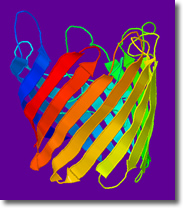|
Welcome! We specialize in custom designed molecular animations (for stand-alone use or integrated into a molecular tour or tutorial) and interactive versions of print media molecular figures.
Animations & Tutorials
Looking for fully interactive, online animations? You've found them. Molecules in Motion has been providing animations of molecules in 3D that are scientifically accurate, beautiful, and clear for over 10 years. Our animations are being featured at the web sites of leading textbooks and journals, in films, and on television. Custom design is our specialty.
Interacting with our animations is as easy as clicking the mouse. Just click and drag to rotate in 3D, click and SHIFT-drag to zoom.

What are Proteins? • View Animation
Composed of twenty different building blocks called amino acids, proteins are the most versatile molecules in biology. Three different proteins illustrate common structural elements of proteins despite their very different functions.
Opsins • View Animation
Take a tour of the proteins that enable the photoreceptor cells of the eye to detect light. Developed with Bruce Patterson of the University of Arizona.
Custom Animation Design
Our custom animations are suitable for web delivery, film or video. They have appeared on the National Geographic Channel and in the documentary film, "Flock of Dodos", as supplements to textbooks including Lehninger's Principles of Biochemistry, Stryer's Biochemistry and others. They can be used for supplementing research publications, teaching, presentations, 3D illustration, or any eye-catching purpose you have in mind. For more information, contact us.
Interactive 3D Figures
Journal Figures Come to Life in 3D
Molecules in Motion figures appear in select Biochemical Journal Reviews. Each interactive, animated figure opens with an exact replica of a print figure in the review, and is supplemented with a control panel to explore the structure at will.
Animation of IRP1 conformational change
Regulation of cellular iron metabolism
Jian Wang and Kostas Pantopoulos
Biochem. J. (2011) 434 (365-381)
Compare 7 exocyst subunit structures
Cell polarity during motile processes: keeping on track with the exocyst complex
Maud Hertzog and Philippe Chavrier
Biochem. J. (2011) 433 (403-409)
CUB domain architecture; zoom in to calcium-binding domain
Structure and properties of the Ca2+-binding CUB domain, a widespread ligand-recognition unit involved in major biological functions
Christine Gaboriaud at al.
Biochem. J. (2011) 439 (185-193)
Trimeric and monomeric structure of a glutamate transporter
The role of amino acid transporters in inherited and acquired diseases
Stefan Bröer and Manuel Palacín
Biochem. J. (2011) 436 (193-211)
Protein-protein interfaces of Mediator complexes
Gene-specific transcription activation via long-range allosteric shape-shifting
Chung-Jung Tsai and Ruth Nussinov
Compare TB, Hybrid and cbEGF domains
TB domain proteins: evolutionary insights into the multifaceted roles of fibrillins and LTBPs
Ian Robertson, Sacha Jensen and Penny Handford
Biochem. J. (2011) 433 (263-276)
High resolution acyl-ACP structure
Current understanding of fatty acid biosynthesis and the acyl carrier protein
David I. Chan and Hans J. Vogel
Biochem. J. (2010) 430 (1-19)
Bone morphogenetic protein and growth differentiation factor cytokine families and their protein antagonists
Christopher C. Rider and Barbara Mulloy
Biochem. J. (2010) 429 (1-12)
Figure 3 Structures of BMP antagonists
Complexes between photoactivated rhodopsin and transducin: progress and questions
B. Jastrzebska, Y. Tsybovsky and K. Palczewski
Biochem. J. (2010) 428 (1-10)
Figure 2 Possible organization of the Rho*-Gt complex in ROS membranes
PRH/Hex: an oligomeric transcription factor and multifunctional regulator of cell fate.
A. Soufi and P.-S. Jayaraman
3D Figure
Paper
Structural biology of plasmid partition: uncovering the molecular mechanisms of DNA segregation. M.A. Schumacher
3D Figure
Paper
The Hsp90 molecular chaperone: an open and shut case for treatment. L.H. Pearl, C. Prodromou and P. Workman
3D Figure
Paper
The histidine phosphatase superfamily: structure and function. D.J. Rigden
3D Figure
Paper
Two independent routes of de novo vitamin B6 biosynthesis: not that different after all. T.B. Fitzpatrick, N. Amrhein, B. Kappes, P. Macheroux, I. Tews and T. Raschle
3D Figure
Paper
Na+/Ca2+ exchangers: three mammalian gene families control Ca2+ transport. J. Lytton
3D Figure
Paper
Structures and metal-ion-binding properties of the Ca2+-binding helix–loop–helix EF-hand motifs. J.L. Gifford, M.P. Walsh and H.J. Vogel
3D Figure
Paper
ACS Chemical Biology papers with Molecules in Motion 3D figures:
HIV-1 Reverse Transcriptase Structure with RNase H Inhibitor Dihydroxy Benzoyl Naphthyl Hydrazone Bound at a Novel Site
Paper (requires subscription)
Mechanistic and Structural Basis of Stereospecific Cβ-Hydroxylation in Calcium-Dependent Antibiotic, a Daptomycin-Type Lipopeptide
Paper (requires subscription)
Structural Basis for High-Affinity Peptide Inhibition of Human Pin1
Paper (requires subscription)
3D Interactive Figures Comparison
Compare still figures and the interactive replicas, side-by-side.
Any molecular structure figure can be adapted for viewing in 3D on a web page. There is no need to install any software for viewing them. They appear in ordinary web pages.
View Example
For more information, view our flyer, or send an emai with your enquiry to friedar@moleculesinmotion.com.
Contact Molecules in Motion
Molecules in Motion is owned and operated by Frieda Reichsman, PhD. Feel free to email her for more information about any Molecules in Motion product, or with questions about any of our materials or technology: friedar@moleculesinmotion.com
|

